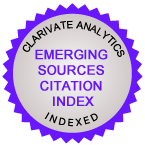Comparative Slavic phraseology and paremiology: Cornerstones and stumbling blocks
DOI:
https://doi.org/10.21638/spbu09.2020.306Abstract
The comparison of phraseological units of various Slavic languages is based on a unified system of concepts and their oppositions. Czech and Russian, Polish and Russian, Russian and Bulgarian, and Russian and Ukrainian idioms and paremias are studied in the article. Russian idioms such as белая ворона, паршивая овца and Polish biały kruk, czarna owca, Czech idioms obĕtní beránek and Russian жертвенный агнец, козел отпущения are examples of comparison. The sources of the material for the study are published bilingual dictionaries of phraseological units, as well as articles by linguists from different countries on this topic. Numerous semantic differences (connotations) were found that confirm the idiomatic character of each language. The equivalence of phraseological units is hindered by their polysemy and different semantic scope. And the content of proverbs reflects more the morality of society at a certain stage of its history than the linguistic image of the world. The influence of the national cultural background on the phraseological productivity (“phrasemogeneity”) of lexemes is demonstrated in the work. In particular, the words цървул, калпак, бъклица, трън, denoting the facts of rural life, are productive for Bulgarian phraseology. An attempt is made in the article to systematize the differential features that distinguish phraseological units of different languages. These are such oppositions as: “person” — “object”, “space” — “time”, “spiritual” — “material”, “assessment: approving/disapproving/neutral”, “external manifestation” — “internal state”, “scale: general — private”, and “stylistic coloring: from rough to sublime”. The depth and thoroughness of the semasiological analysis revise the thesis about the universal phraseological fund. The article discusses and develops some provisions of professor Valery Mokienko’s concept.
Keywords:
phraseology, paremia, comparison, Slavic languages, connotation
Downloads
References
Алпатов 2014 — Алпатов В.М. О двух «детских болезнях» современной лингвистики (язык, идеология, речевые жанры). Жанры речи. 2014. № 1–2: 9–15.
Голяк 2003 — Голяк С.В. Активность слова и ее проявления во фразеологии (на материале сербских и белорусских зоонимов). Веснiк Беларускага дзяржаўнага унiверсiтэта. Серыя 4. 2003. № 1: 52–57.
Горды 2010 — Горды М. Соматическая фразеология современных русского и польского языков. Щецин: voluminal. pl, 2010. 364 с.
Гридина, Коновалова 2019 — Гридина Т.А., Коновалова Н.И. Зооморфизмы как основа моделирования фразеологической семантики: русско-польские соответствия. Русин. 2019. Т. 56: 198–212. https://doi.org/10.17223/18572685/56/12.
Мокиенко 1976 — Мокиенко В.М. Эксплицитность и развитие фразеологии. SLAVIA.Ročnik XLV. 1976. Čislo 2: 113–131.
Мустайоки 2006 — Мустайоки А. Теория функционального синтаксиса: От семантических структур к языковым средствам. М.: Языки славянской культуры, 2006. 512 с.
Алпатов 2014 — Alpatov V.M. About two “childhood diseases” of modern linguistics (language, ideology, speech genres). Zhanry rechi. 2014, (1–2): 9–15. (In Russian)
Голяк 2003 — Goliak S.V. The activity of a word and its manifestations in phraseology (based on material from Serbian and Belarusian zoonyms). Vesnik Belaruskaga dziarzhaunaga universiteta. Seryia 4. 2003, (1): 52–57. (In Russian)
Горды 2010 — Gordy M. Somatic phraseology of modern Russian and Polish languages. Shchetsin: voluminal. pl, 2010. 364 p. (In Russian)
Гридина, Коновалова 2019 — Gridina T.A., Konovalova N.I. Zoomorphisms as the basis for modeling phraseological semantics: Russian-Polish correspondences. Rusin. 2019. Vol. 56: 198–212. https://doi. org/10.17223/18572685/56/12. (In Russian)
Мокиенко 1976 — Mokienko V.M. Explicitity and development of phraseology. SLAVIA. Ročnik XLV. 1976. Čislo 2: 113–131. (In Russian)
Мустайоки 2006 — Mustajoki A. Theory of functional syntax: From semantic structures to language means. Moscow: Iazyki slavianskoi kul’tury Publ., 2006. 512 p. (In Russian)
Downloads
Published
How to Cite
Issue
Section
License
Articles of "Vestnik of Saint Petersburg University. Language and Literature" are open access distributed under the terms of the License Agreement with Saint Petersburg State University, which permits to the authors unrestricted distribution and self-archiving free of charge.






